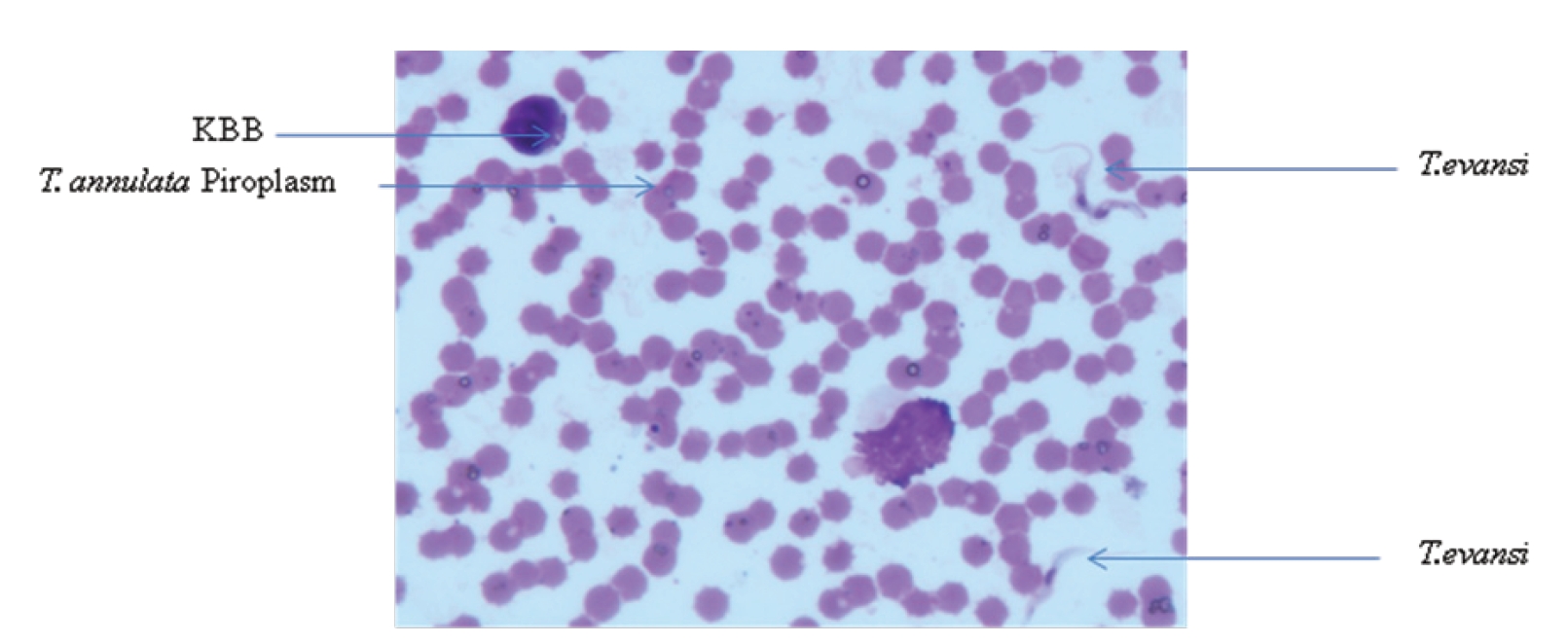Efficacy of buparvaquone in pcr confirmed concurrent infection of Trypansoma evansi and Theileria annulata in buffaloes
DOI:
https://doi.org/10.56825/bufbu.2023.4224141Keywords:
Bubalus bubalis, buffaloes, Trypansoma evansi, Theileria annulata, buparvaquone, PCRAbstract
Five buffaloes, 5 to 7 years old in the month of July 2015 with history of high rise of temperature, nasal discharge, exophthalmia, excitement, lacrimation, salivation, dyspnea, generalised lymphadenopathy, especially in the prescapular lymph nodes were attended at a farm in Mahakaushal region of Madhypradesh. By blood smear and polymerase chain reaction analysis, it was determined that all the buffaloes had mixed infections of T. evansi and T. annulata. The treatment of all five buffaloes was initiated with single deep intramuscular injection of diminazine acceturate 3.5 mg/kg body weight along with three dosages of long acting oxytetracycline 20 mg/kg b.wt. on alternate day. A single injection of buparvaquone on the fourth day (in 3 cases) and two doses of buparvaquone (2.5 mg kg-1) at 48 h intervals (in 2 cases) were administered. Only 3 buffaloes showed uneventful recovery after a single injection with buparvaquone. When the blood samples of all the five buffaloes were again analyzed by PCR and found all the samples were negative for T. evansi and T. annulata except two buffaloes (Two cases hading two doses of buparvaquone) which were positive for T. annulata in spite of giving the second dose of buparvaquone. The study indicated that there might be reduced efficacy or resistance of T. annulata against buparvaquone.
Downloads
Metrics
References
Aregawi, W.G., G.E. Agga, R.D. Abdi and P. Büscher. 2019. Systematic review and meta-analysis on the global distribution, host range, and prevalence of Trypanosoma evansi. Parasite. Vector., 12(1): 67. DOI: 10.1186/s13071-019-3311-4.
Coles, E.H. 1986. Veterinary Clinical Pathology, 4th ed. W.B. Saunders Co. Philadelphia, USA.
d’Oliveira, C., M. Van Der Weide, M.A. Habela, P. Jacquiet and F. Jongejan. 1995. Detection of Theileria annulata in blood samples of carrier cattle by PCR. J. Clin. Microbiol, 33(10): 2665-2669. DOI: 10.1128/JCM.33.10.2665-2669.1995.
Fukasawa, M., T. Kikuchi, S. Konashi, N. Nishida and T. Yamagishi 2003. Assessment of criteria for improvement in Theileria orientalis sergenti infection tolerance. Anim. Sci. J., 74: 67-72. DOI: 10.1046/j.1344-3941.2003.00088.x
Gill, B.S. 1991. Trypanosomes and Trypanosomiases of Indian Livestock, Indian Council for Agricultural Research, New Delhi, India.
Hyde, J.E. 2007. Drug-resistant malaria - An insight. FEBS J., 274(18): 4688-4698. DOI: 10.1111/j.1742-4658.2007.05999.x
McHardy, M. 1991. Butalex (Buparvaquone) - A new therapeutic for theileriosis with comments on its value in an integrated control strategy, p. 133-140. In Singh, D.K. and B.C. Varshney (eds.) The Proceeding of the Second EEC Workshop on Orientation and Coordination of Research on Tropical Theileriosis. National Dairy Development Board, Anand, India.
Mhadhbi, M., A. Naouach, A. Boumiza, M.F. Chaabani, S. BenAbderazzak and M.A. Darghouth. 2010. In vivo evidence for the resistance of Theileria annulata to buparvaquone. Vet. Parasitol., 169(3-4): 241-247. DOI: 10.1016/j.vetpar.2010.01.013.
Ramyadevi, R. and K.K. Ponnuswamy. 2020. Successful therapeutic management of concurrent infection of babesiosis and theileriosis in a Holstein Friesian calf. International Journal of Current Microbiology and Applied, 9(8): 1226-1228. DOI: 10.20546/ijcmas.2020.908.137
Soulsby, E.J.L. 1982. Helminths, Arthropods and Protozoa of Domesticated Animals, ELBS-7 Bailliere Tindal, London, UK. p. 728-737.
Wilkie, G.M., C.G. Brown, B.E. Kirvar, M. Thomas, S.M. Williamson, L.J. BellSakyi and O. Sparagano. 1998. Chemoprophylaxis of Theileria annulata and Theileria parva infections of calves with buparvaquone. Vet. Parasitol., 78(1): 1-12. DOI: 10.1016/s0304-4017(98)00126-5.
Wuyts, N., N. Chokesajjawatee and S. Panyim. 1994. A simplified and highly sensitive detection of Trypanosoma evansi by DNA amplification. Southeast Asian J. Trop. Med. Public Health, 25(2): 266-266.









.png)








